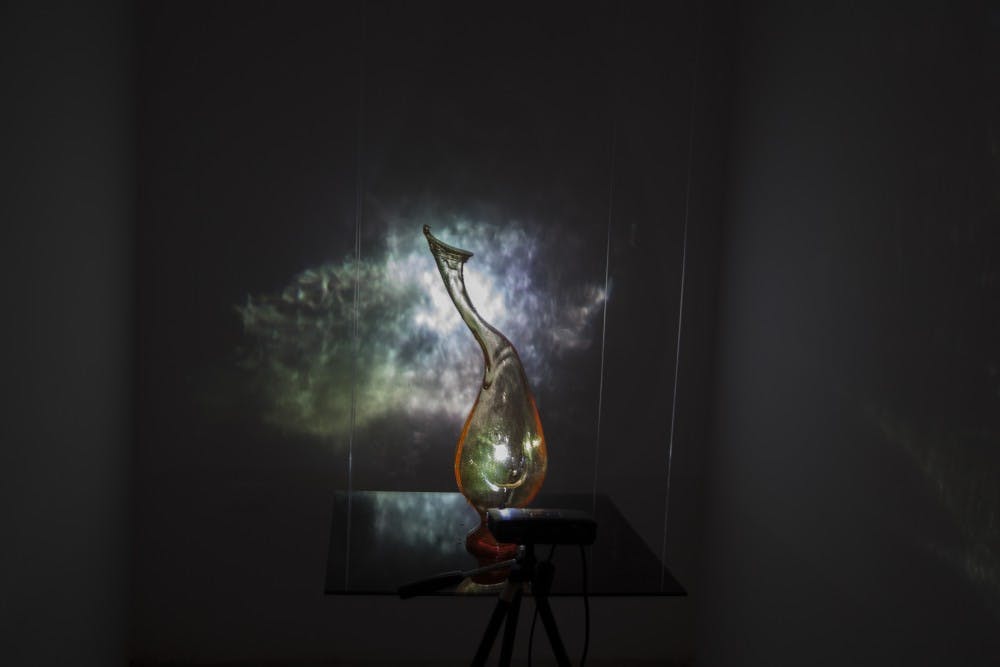Visiting artist Azi Amiri is seeking to transform negative subject matter, such as the impacts of war, into a positive visual experience while inspiring young artists to pursue their dreams.
The New York based artist will be exploring these themes when she gives her guest lecture at the ASU Art Museum on Feb. 23.
The lecture is being organized as a part of the Emerging Curators Initiative at Phoenix Institute for Contemporary Art (phICA), which gives budding art curators the opportunity to organize an entire show from beginning to end.
Amiri's lecture was designed to accompany her "Turtles Cry When They Fly" exhibition, which is currently on display at phICA.
The emerging curator who organized the exhibition is Ellee Bokharachi, who said she first discovered Amiri's work during a trip to New York in 2014 and knew immediately that she wanted to show that piece at some point.
Bokharachi explained that her decision to host the lecture at the ASU Art Museum was very deliberate, and that the museum's history of displaying very diverse international exhibitions made it a relevant venue for this lecture. She also wanted to make the lecture more accessible to a wider audience, particularly college students.
Bokharachi said she hopes Amiri's lecture and exhibition will have a profound impact on those who engage with them.
"I hope other artists can somehow relate and that people get some exposure to another culture and find more curiosity," she explained. "And I hope they leave it with even more questions."
Bokharachi said "Turtles Cry When They Fly" carries very important messages about war and is made even more profound by its interactivity and composition.
"The piece physically falls down at end of night," she explained. "It shows how wars affect human beings and societies. It's important to know that humanity and creativity cannot flourish during a time of war."
Amiri, who moved to the U.S. from Tehran, Iran in 2008, described her exhibition as a statement of interaction and reaction over time. It is made of two main components: a video and a sugar container.
The video is a slowed down scene from an Iranian war film that Amiri said touched her profoundly. She then projected the film clip through the sugar container, which is melted down over time by changes in the environment. Even changes as natural as human breath, crowds of people, humidity and body temperature cause the container to melt down and ultimately reveal a clear image of the film.
Amiri said this design was intended to allow the audience to use their imaginations.
"One of the things I learned here is that we’re a very distracted society," she explained. "I’d be happy to hear that there are people who spend time, even just two minutes, with my work. And connecting with the work not just visually, but rationally."
While Amiri said her lecture will address the background of this particular exhibition, it will mainly focus on discussing the inspiration and influence behind her body of work as a whole, as well as her own development as an artist.
One thing she said she will address is her ability to express an unfortunate circumstance through a beautiful work of art.
"My works are very topical," she explained. "And those topics are not very pleasing, so I have to deal with these topics in a way that I kind of create a juxtaposition of subject matter with a visually pleasing quality."
Amiri said she will also be discussing the "ephemeral" nature of her recent works in addition to the narrativity of her works, which tell stories that come from her own experiences. She said she is excited to share these thoughts with audience members of all ages, but offered special advice for aspiring collegiate art students.
"When you're in school, you have consistently good conversations and mentors ... but when you graduate, suddenly you're on your own," she said. "I think you need to continue to do whatever you believe you should do. Follow what’s inside of you. In school, you have support, but after, you need to take care of it."
She also encouraged young artists to stay proactive and productive and to take advantage of the possibilities they have, even if that means drawing while riding public transportation or sharing work on Facebook.
Amiri will be explaining her own artistic evolution in her lecture at the ASU Art Museum on Feb. 23 at 5:30 p.m. Her "Turtles Cry When They Fly" exhibition will be on display at phICA from Feb. 19 to March 11.
Reach the reporter at celina.jimenez@asu.edu or follow @lina_lauren on Twitter.
Like The State Press on Facebook and follow @statepress on Twitter.




